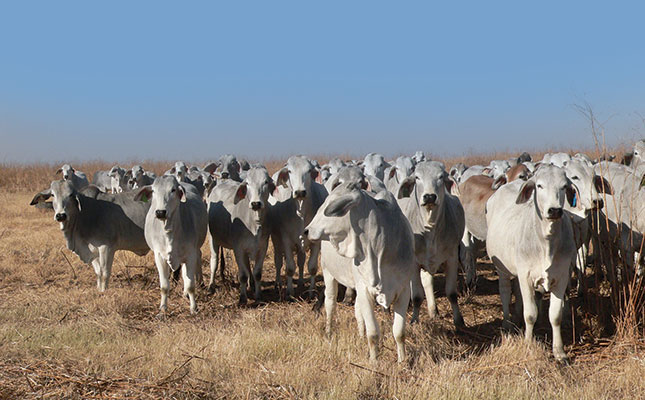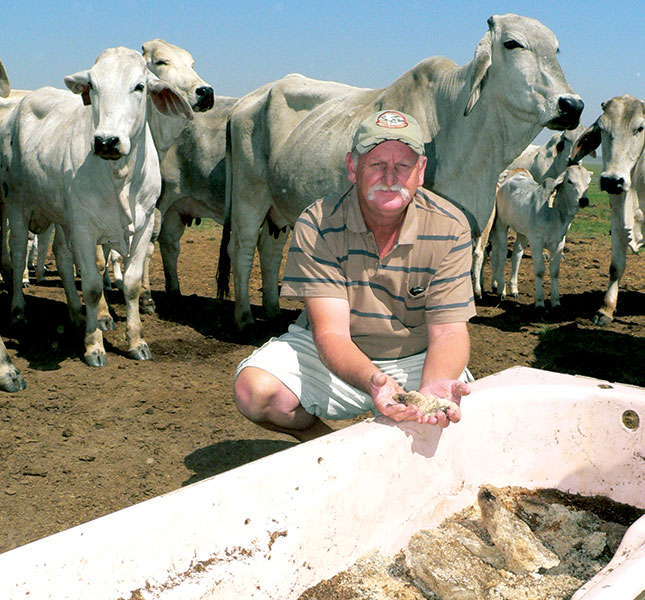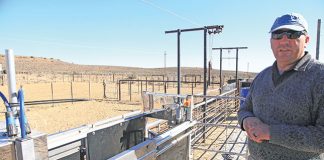
Photo: Lloyd Phillips
Accountant Neil Haines had little farming experience when he started his Brahman enterprise in 1995.
But by visiting successful beef farmers, he picked up tips on how to run a thriving business.
One idea that really stood out for him was allowing nature and the natural instincts of the animals to guide the management programme.
He has rapidly expanded his award-winning Van Farms Grey Manso Brahman and commercial Brahman-type beef enterprises to where he now runs 1 200 stud animals and 500 commercial breeding cows on three farms totalling 2 400ha near Ladysmith, KwaZulu-Natal.
A technical start
“When I first started with my Brahmans, I went by the book, farming technically,” he explains. “I used vet-recommended vaccination programmes, controlled breeding and calving seasons, and specialised supplementary feeding.
“But I soon figured out that these ate into profits and were sometimes even wasteful. Also, I’d have cows that were good animals but that, for reasons not necessarily related to their capabilities, would have had to be culled if I followed conventional methods.”

Neil realised he’d get the most out of his animals by adapting his beef production and breeding programmes to nature.
For one thing, he saw how many cattle raised on communal land by cash-strapped farmers using hardly any vaccinations still produced and raised a calf every year – and decided to take a similar approach.
Now, every September, animals older than six months are weighed and then get a 3-in-1 Supervax vaccination (for anthrax, botulism and black quarter), another vaccination for lumpyskin disease, and one for contagious abortion.
Since starting this vaccination programme, no major diseases have been detected. He is thus taking advantage of the Brahman’s inherent hardiness instead of over-vaccinating and potentially undermining the breed’s natural tolerance to many diseases.
Mating and calving
When it comes to mating and calving cycles, Neil takes a “hands-off approach”.
His biggest intervention is choosing the bull he wants to run with a particular group of Brahman females.
For his commercial herd, Neil used to put a bull to the cows from January until the end of March or early April, so the females could calve nine months later, in spring and summer, when grazing is at its best.
However, he soon discovered that, almost without fail, around 20% of them wouldn’t conceive during this breeding season.
“This was a waste, because I’d rather have 20% produce poor calves with poor weaning weights, instead of no calves at all,” explains Neal.
“A cow won’t conceive if she’s not above a body condition score (BCS) of 3 and on a rising plane of nutrition. In most cases, if a cow doesn’t meet this criteria, it’s due to herd management problems and she’ll be given a second chance to conceive. But if the problem is with the cow, then she will be culled,” he adds.
By allowing his Brahmans to breed according to their natural instincts, Neil has achieved better conception and weaning weights, putting more money in his pocket.
A new bull will be used in a particular herd in January and remain there until swopped with another. Some 80% of the cows will conceive and calve in August and September, when veld grazing is starting to regenerate after winter.
By the time the calves start moving onto grass from two months after calving, the grass will be at its most abundant, palatable and nutritious.
A second chance
Neil says there might be several reasons why 20% of his Brahman females didn’t conceive in January and February.
Firstly, the bull in a particular female herd might not have been able to cover all the cows coming into oestrus.
A Brahman female cycles for 24 hours and is unreceptive to the bull for the next month or so, and the bull might have missed this initial opportunity.
A cow missed during the first cycle can conceive during her next cycle and produce a great calf.
Secondly, a cow might not conceive if her BCS is incorrect when the bull is put into the herd. This could be because her calf at foot was very demanding in its milk requirements, or the cow didn’t cycle in her usual time period because she was still recovering from an illness.
“Even changes in seasonal weather patterns can influence a female’s natural breeding and calving cycle,” explains Neil. “If spring starts late, many cows won’t cycle until it properly kicks in and veld growth reaches an optimal level. Their instinct tell them to breed when conditions are right.
“Other farmers might artificially improve their females’ BCS and put them on a rising plane of nutrition by using supplementary feeds such as lucerne bales, chicken litter and concentrates. But I want my enterprises to be cost-effective and I’d rather use free grazing and let nature take its course.”
Feed
The 600ha Netherton, 600ha Mine Own and 1 200ha Ravensdale farms that make up Neil’s Van Farms operation get an average annual rainfall of 900mm. He grows yellow maize every summer for his on-farm feed mill, and the maize lands yield around 8t/ha.
The remainder of the farms have natural sweetveld grazing interspersed with Acacia trees.
From about September to mid-April, Neil supplements grazing with an ad lib ration of 40kg bonemeal and 25kg salt mixed into a single trough, with another trough of plain salt lick nearby.
“I’ve replaced phosphate licks during summer with bonemeal because the cattle can decide what mineral they need when,” explains Neil.
“In the wild, when herbivores need calcium, they’ll often chew on bones. If they need salt, they’ll lick rocks and chew soil.
“It’s self-regulating behaviour and I want my cattle to self-regulate their mineral intake.
“I also believe a lot of the vitamins in today’s supplementary feeds and licks go to waste, because the cattle’s digestive system can’t properly absorb it all. ”
In winter, from May to August, Neil replaces the bonemeal and salt mixture with an ad lib ration of Voermol’s Premix 450, but keeps the plain salt lick nearby.
He feeds his cattle with bales of natural veld grass and his stud animals will also be put onto maize stover.
The stud Brahmans typically graze on fallen cobs and the stover from the beginning of July to the end of August, and will only get bales of natural veld grass if the stover is running low on edible dry matter.
Neil says he knows it’s time to move his stud animals back onto natural veld when they stand waiting at the gate instead of foraging in the stover.
Stocking
Contrary to the widely used stocking capacity in his area of 3ha/MLU, Neil uses a 1:1 ratio.
This is because he has so much veld growth on his farms in summer and it could become a fire hazard in winter.
The heavier grazing pressure on Van Farms keeps the grass shorter, stimulating better regrowth and palatability – and better utilisation by the cattle, resulting in good weight gain.
For his commercial beef herd, Neil has four 150ha camps and puts the whole herd into one camp at a time. Once again, when he sees the cows linger by the gate, they are moved to a new camp.
Dipping
“I prefer to dip my Brahmans as little as possible to let them build up a natural immunity to tick-borne diseases. I have high redwater, heartwater and gallsickness threats due to the movement of wild animals such as kudu,” says Neil.
“I visually evaluate tick loads to decide when to dip the animals. During summer, this usually works out to about every six weeks.
I use pour-on dips applied in a crush so that the applications are controlled and consistent, and I alternate the active ingredients amitraz, flumethrin and amitraz, cypermethrin and piperonyl butoxide each dipping. I’ve found this works very well. I only lose about 10 animals a year from redwater and heartwater in my herds.”
Weaning
Neil allows his cattle to naturally wean their calves when they’re ready. In the commercial herd, heifers are never force-weaned and also remain with their mothers until the mothers are culled or sold.
A cow weans her calf when she’s due to have her next calf. Neil finds that natural weaning doesn’t stress the mothers and the calves grow out strong and healthy on a mix of mother’s milk and grazing.
Neil retains about 50 commercial heifer calves for his own use and sells the rest.
Bull calves from the commercial herd are sold off their mothers to feedlotters at eight months at a liveweight of 240kg to 260kg.
In the stud Brahman herd, all heifers and bull calves are weaned naturally when the cows are ready to calve. Sometimes, if a cow hasn’t weaned her calf yet, the calf will be allowed into the calving camp until the new calf is born.
Only then is it taken away.
Stud bull calves will be grown out on-farm and then selected for selling or use on Van Farms, while the 39 replacement heifer calves will be put in a different herd to their mothers to control bloodlines and genetics. Other stud heifers will be sold.
Neil’s selected heifers are immediately put into a single-sire herd even though they are less than a year old.
The heifers will only start cycling for breeding when they reach 350kg liveweight on a rising plane of nutrition, normally at around 20 months old.
Every year, on average, Neil markets 100 3-year-old Grey Manso stud Brahman bulls; 100 stud Grey Manso heifers; 250 commercial Brahman-type heifers; and 250 commercial Brahman-type weaner bull calves in August.
“My good production results and bank balance speak for themselves,” says Neil.
Contact Neil Haines on 082 800 3023, or email [email protected].













